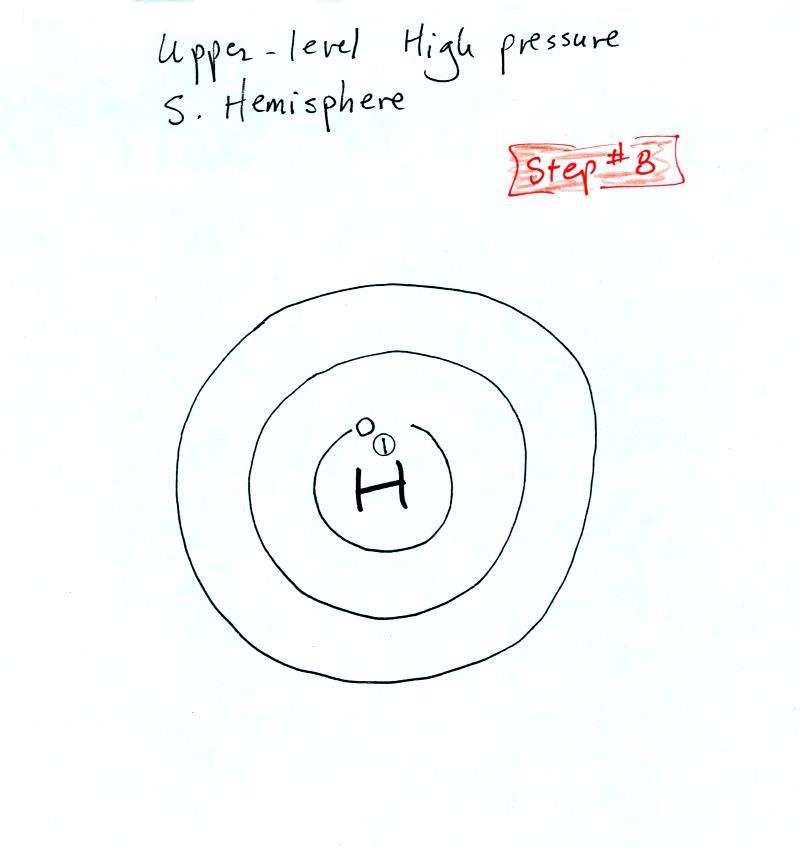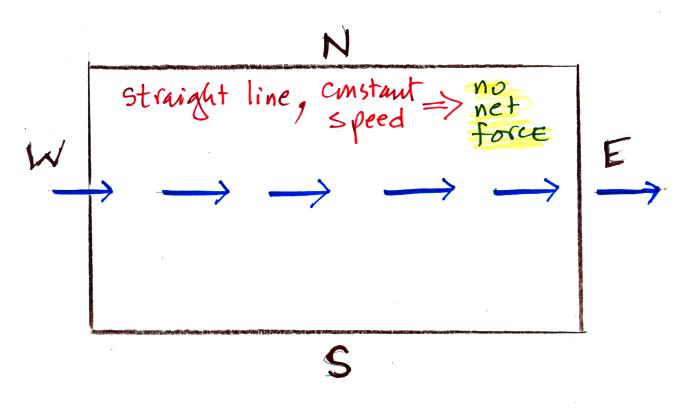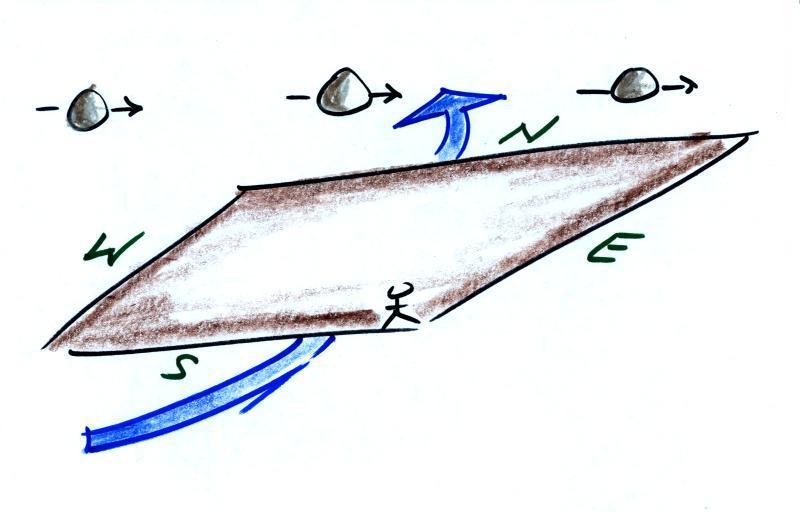This is a southern hemisphere upper level center of high
pressure. You should be able to figure out how the winds will
blow in this
case. You'll find the answer at the end of today's
notes.
Upper level winds blow parallel to the contour
lines. Now we'll try to understand why friction causes surface
winds to
blow across the contour lines (always toward low pressure).

We add friction in the second picture. It points in a direction
opposite the wind and can only slow the wind down. The strength
of the frictional force depends on wind speed (no frictional force if
the wind is calm) and the type of surface the wind is blowing over
(less
friction when wind blows over the ocean, more frictional force when the
wind is blowing over land).
Slowing the wind weakens the CF and it can no longer balance the
PGF (3rd figure). The stronger PGF causes the wind to turn and
start to blow across the
contours toward Low. This is shown in the 4th figure.
Eventually the CF and Frictional force, working together, can balance
out the PGF. The net force would again equal zero and
the wind would blow in a straight line at constant speed acrosss the
contours toward low pressure.
What we've learned from the straight contour example, namely
that
the winds will blow across the contours toward low pressure can be
applied to a curved contour pattern. The figure below
wasn't shown in class.
If you take a small little piece of
a curved pattern and magnify it, it will look straight.
Now our last step, surface winds blowing around H and L in the NH
and SH.

It is easy to figure out
which of
the figures are centers of
low pressure (the wind blows inward toward the center of the
picture) The winds are spiralling inward in the top and
bottom
examples (1 and 3).
These must be surface centers of low pressure. The winds are
spiraling outward from the centers of high pressure (2 and 4).
Now you probably don't want to figure out which of these are northern
and which are southern hemisphere pictures. It is probably best
to remember one of the pictures. Remember in 1, for example, that
surface winds spin
counterclockwise and spiral inward around centers of
low pressure in the northern hemisphere (something we learned
early in
the semester). Then remember that winds spin in the other
direction and blow outward around high pressure in the northern
hemisphere (2). The spinning directions of the winds reverse when
you move from the northern to the southern hemisphere. Thus you
find clockwise spinning winds and inward motion around low pressure (3)
and counterclockwise and outward spiraling winds around high pressure
in the southern hemisphere.
Converging winds cause air to
rise. Rising air expands and cools and can cause clouds to
form. Clouds and stormy weather are associated with surface low
pressure in both hemispheres. Diverging winds
created sinking wind motions and result in clear skies.
Next we
had a short look at the cause of the Coriolis force. The pictures
that follow aren't in the ClassNotes.
Imagine something flies
over Tucson. It
travels
straight from west to east at constant speed. You
would,
more
or
less
subconciously,
plot its path relative to the ground.
The
next
figure
shows
the
path that
the object followed as it passed over the city.
Here's the path the moving object
would appear to follow
relative to the ground. Based on this straight line,
constant speed trajectory you'd conclude there was
no net force acting on the object (and again no net force doesn't mean
there aren't any forces, just that they all cancel each other out so
the total force is zero).
In this second picture the object
flies by overhead
just as it
did in the previous picture. In this picture, however, the ground
is moving (don't worry about what might be causing the ground to
move). What would you say happened when viewing the flyby from
the ground?
The path, relative to the ground, would look something like this.
It
would
no
longer
appear
to
be
moving
from
W
to E but rather from the NW toward
the SE.
It's
still straight line motion at constant speed, though, so you
conclude there was no net force acting on the object.
Now the ground is moving and
also spinning.
The path of the object plotted
on the ground appears to be
curved. But remember that's relative to the ground and the ground
is spinning. We could take the ground's motion into account or
just ignore
it. In the latter case you'd conclude that
there was a net force
perpendicular and to the right of the moving object. This net
force would be needed to explain the curved path that the object
appears to be
following.
At most locations on the earth the ground IS rotating. This
is
most easily seen at the poles.

Imagine a piece of paper glued to
the top of a globe.
As the
globe spins the piece of paper will rotate. A piece of paper
glued to the globe at the equator won't spin, it will flip over.
At points in between the paper would spin and flip, the motion gets
complicated.
The easiest thing for us to do is to ignore or forget about the
fact that the
ground on
which we are standing is rotating. We do still need to account
for the curved paths that moving objects will take when they
move relative to the earth's surface. That is what the Coriolis
force does.
And that's the reason for another 1S1P
Bonus
Assignment. Foucault's Pendulum was the first demonstration
that proved that
the ground we're standing on (at most
locations on earth) is spinning. Here's a photograph of a
Foucault Pendulum at the Pantheon
in Paris (Foucault conducted his demonstration apparently at the Paris
Observatory).
Here's the answer to the question embedded in today's notes.
The figure below shows the upper level winds that blow around H
pressure in the SH hemisphere.














